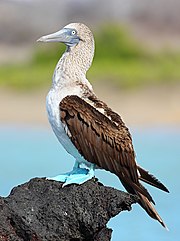Booby
| Booby Temporal range: Miocene (Langhian) – recent[1]
| |
|---|---|

| |
| Blue-footed boobydisplaying by raising a foot | |
| Scientific classification | |
| Domain: | Eukaryota |
| Kingdom: | Animalia |
| Phylum: | Chordata |
| Class: | Aves |
| Order: | Suliformes |
| Family: | Sulidae |
| Genus: | Sula Brisson,1760 |
| Type species | |
| Pelecanus leucogaster Boddaert,1783
| |
| |||||||||||||||||||||||||||||||||
| Cladogram showing the species in the genusSula.[2] |
Aboobyis aseabirdin thegenusSula,part of thefamilySulidae.Boobies are closely related to thegannets(Morus), which were formerly included inSula.
Systematics and evolution
The genusSulawas introduced by the French zoologistMathurin Jacques Brissonin 1760.[3]Thetype speciesis thebrown booby.[4]The name is derived fromsúla,theOld NorseandIcelandicword for the other member of the familySulidae,thegannet.[5]
The English name "booby" was possibly based on theSpanishslangtermbobo,meaning "stupid",[6]as these tame birds had a habit of landing on board sailing ships, where they were easily captured and eaten. Owing to this, boobies are often mentioned as having been caught and eaten by shipwrecked sailors, notablyWilliam Blighof theBountyand his adherents during their famous voyage after being set adrift byFletcher Christianand his followers.[7]
Six of the ten extant Sulidae species calledboobiesare in the genusSula,while the three gannet species are usually placed in the genusMorus.[8]Abbott's boobywas formerly included inSulabut is now placed in amonotypicgenusPapasula,which represents an ancient lineage perhaps closer toMorus.Some authorities consider that all ten species should be consideredcongenericinSula.However, they are readily distinguished by means ofosteology.The distinct lineages of gannets and boobies are known to have existed in such form, since at least the MiddleMiocene,c. 15mya.[9]
The fossil record of boobies is not as well documented as that ofgannets,either because booby speciation was lower from the lateMioceneto thePliocene(when gannet diversity was at its highest), or because the booby fossil species record is as yet incomplete due to most localities beingequatorialor in theSouthern Hemisphere.
Behaviour
Boobies hunt fish by diving from a height into the sea and pursuing their prey underwater. Facial air sacs under their skin cushion the impact with the water. Boobies are colonial breeders on islands and coasts. They normally lay one or more chalky-blue eggs on the ground or sometimes in a tree nest. Selective pressures, likely through competition for resource, have shaped the ecomorphology and foraging behaviours of the six species of boobies in the Pacific.[10]
List of species
| Common name | Scientific name and subspecies | Range | Size and ecology | IUCN status and estimated population |
|---|---|---|---|---|
| Blue-footed booby | Sula nebouxii Milne-Edwards,1882 Two subspecies
|
Gulf of California down along the western coasts of Central and South America down to Peru
|
Size: Habitat: Diet: |
LC |
| Brown booby | Sula leucogaster (Boddaert,1783) Four subspecies
|
islands and coasts in the pantropical areas of the Atlantic and Pacific oceans
|
Size: Habitat: Diet: |
LC |
| Masked booby | Sula dactylatra Lesson,1831 Four subspecies
|
islands in tropical oceans
|
Size: Habitat: Diet: |
LC |
| Nazca booby | Sula granti Rothschild,1902 |
eastern Pacific from the islands in Baja California to the Galapagos islands and the Isla de la Plata in Ecuador and Malpelo in Colombia
|
Size: Habitat: Diet: |
LC |
| Peruvian booby | Sula variegata (Tschudi,1843) |
Peru
|
Size: Habitat: Diet: |
LC |
| Red-footed booby | Sula sula (Linnaeus,1766) Three subspecies
|
Sri Lanka, Christmas Island, eastern central Pacific
|
Size: Habitat: Diet: |
LC |
References
- ^"Sula Brisson 1760 (booby)".PBDB.Archivedfrom the original on 2021-08-08.Retrieved2019-07-08.
- ^Patterson, S.A.; Morris-Pocock, J.A.; Friesen, V.L (2011). "A multilocus phylogeny of the Sulidae (Aves: Pelecaniformes)".Molecular Phylogenetics and Evolution.58(2): 181–191.Bibcode:2011MolPE..58..181P.doi:10.1016/j.ympev.2010.11.021.PMID21144905.
- ^Brisson, Mathurin Jacques(1760).Ornithologie, ou, Méthode contenant la division des oiseaux en ordres, sections, genres, especes & leurs variétés(in French and Latin). Vol. 1. Paris: Jean-Baptiste Bauche.Vol. 1 p. 60,Vol. 6 p.494.
- ^Mayr, Ernst;Cottrell, G. William, eds. (1979).Check-list of Birds of the World.Vol. 1 (2nd ed.). Cambridge, Massachusetts: Museum of Comparative Zoology. p. 181.Archivedfrom the original on 2021-08-08.Retrieved2017-11-21.
- ^"Sula, n.".Oxford English Dictionary(Online ed.).Oxford University Press.(Subscription orparticipating institution membershiprequired.)
- ^"booby, n.".Oxford English Dictionary(Online ed.).Oxford University Press.(Subscription orparticipating institution membershiprequired.)
- ^Alexander, Caroline (25 May 2004).The Bounty: The True Story of the Mutiny on the Bounty.Penguin Books.ISBN978-0142004692.
- ^Friesen, V. L.; Anderson, D. J.; Steeves, T.E.; Jones, H.; Schreiber, E.A. (2002). "Molecular support for species status of the Nazca Booby".The Auk.119(3): 820–826.doi:10.1642/0004-8038(2002)119[0820:MSFSSO]2.0.CO;2.S2CID82903466.
- ^Olson, Storrs L.(1985)."The Fossil Record of Birds (Section X.G.5.aSulidae) ".In Farner, D.S.; King, D.S.; Parkes, K.C. (eds.).Avian Biology.Vol. 8. New York: Academic Press. pp. 79–238 [203–204].hdl:10088/6553.Archivedfrom the original on 2021-04-10.Retrieved2017-11-22.
- ^van Oordt, F.; Torres-Mura, J. C.; Hertel, F. (2018). "Ecomorphology and foraging behaviour of Pacific boobies".Ibis.160(2): 313–326.doi:10.1111/ibi.12545.
- ^BirdLife International (2018)."Sula nebouxii".IUCN Red List of Threatened Species.2018:e.T22696683A132588719.doi:10.2305/IUCN.UK.2018-2.RLTS.T22696683A132588719.en.Retrieved13 November2021.
- ^BirdLife International (2018)."Sula leucogaster".IUCN Red List of Threatened Species.2018:e.T22696698A132590197.doi:10.2305/IUCN.UK.2018-2.RLTS.T22696698A132590197.en.Retrieved13 November2021.
- ^BirdLife International (2018)."Sula dactylatra".IUCN Red List of Threatened Species.2018:e.T22736173A132666363.doi:10.2305/IUCN.UK.2018-2.RLTS.T22736173A132666363.en.Retrieved13 November2021.
- ^BirdLife International (2018)."Sula granti".IUCN Red List of Threatened Species.2018:e.T22728990A132659882.doi:10.2305/IUCN.UK.2018-2.RLTS.T22728990A132659882.en.Retrieved13 November2021.
- ^BirdLife International (2018)."Sula variegata".IUCN Red List of Threatened Species.2018:e.T22696686A132589026.doi:10.2305/IUCN.UK.2018-2.RLTS.T22696686A132589026.en.Retrieved13 November2021.
- ^BirdLife International (2018)."Sula sula".IUCN Red List of Threatened Species.2018:e.T22696694A132589278.doi:10.2305/IUCN.UK.2018-2.RLTS.T22696694A132589278.en.Retrieved13 November2021.
External links
- Videos of several Booby species onThe Internet Bird Collection.Archived12 April 2016 at theWayback Machine.







